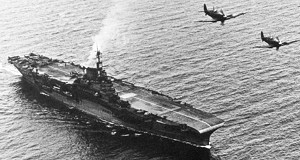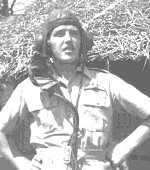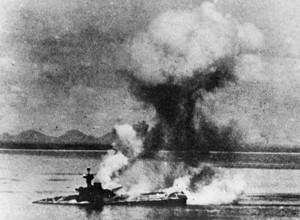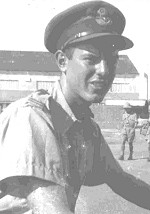
| |

Royal Air Force History
The Battle of Ceylon - 1942 - Part 2
by Wg Cdr John Barras
30 Squadron and the air battle over Colombo - 5th April 1942
The decision to send 30 Squadron to Ceylon was made in early February 1942. Declared non-operational on the 16th February, they moved via Heliopolis to Port Tewfik on the Red Sea. The main party embarked on the Princes Kathleen on 22nd February and the air party including a 196 man servicing party, embarked on HMS Indomitable, sailing for Ceylon on the 26th February.
 All
available hands began assembling the crated Hurricanes on the ship's
hangar deck on the 5th March, and on the following morning 20 Hurricanes
took off, bound for Ratmalana airfield, Colombo. Nineteen of the aircraft
landed safely at Ratmalana, but one, flown by Sergeant Whittaker, landed
back on the carrier after experiencing engine trouble; a remarkable feat
considering that he had no tail hook and this was his first deck landing!
All
available hands began assembling the crated Hurricanes on the ship's
hangar deck on the 5th March, and on the following morning 20 Hurricanes
took off, bound for Ratmalana airfield, Colombo. Nineteen of the aircraft
landed safely at Ratmalana, but one, flown by Sergeant Whittaker, landed
back on the carrier after experiencing engine trouble; a remarkable feat
considering that he had no tail hook and this was his first deck landing!
 Stores and personnel arrived
at Ratmalana on the 11th March, and the Squadron was declared operational
on the 19th March. Routine training continued until 28th March when an
intelligence report was received confirming that the Japanese Fleet had
left the East Indies bound for Ceylon. On the 29th March, 30 Squadron
had all 24 of its Hurricanes serviceable and airborne in mass formation
over Colombo; morale was high and crews were reported as expectant and
ready for operations.
Stores and personnel arrived
at Ratmalana on the 11th March, and the Squadron was declared operational
on the 19th March. Routine training continued until 28th March when an
intelligence report was received confirming that the Japanese Fleet had
left the East Indies bound for Ceylon. On the 29th March, 30 Squadron
had all 24 of its Hurricanes serviceable and airborne in mass formation
over Colombo; morale was high and crews were reported as expectant and
ready for operations.
 Just
before dusk on the 4th April, a Catalina flown by 413 Squadron's CO,
Squadron Leader Birchall, sighted a large Japanese fleet 400 miles south
of Ceylon. His radio operator managed to transmit the location of the
fleet before their aircraft was shot down by 6 Zero fighters from the
carrier Hiryu. The Japanese now knew that their presence had been detected,
so they began preparations for an attack against Colombo the following
morning. Shortly after first light, they launched a force of 125 aircraft
under the command of Commander Mitsuo Fuchida of the Akagi, who had led
the attack on Pearl Harbour. Fuchida's force comprised 36 Val dive bombers,
53 Kate attack bombers, and an escort of 36 Zeros. Admiral Nagumo kept
the rest of his force, approximately another 180 aircraft, in reserve
as a second wave, to be launched once Fuchida had confirmed the location
of the Eastern Fleet, his principle target.
Just
before dusk on the 4th April, a Catalina flown by 413 Squadron's CO,
Squadron Leader Birchall, sighted a large Japanese fleet 400 miles south
of Ceylon. His radio operator managed to transmit the location of the
fleet before their aircraft was shot down by 6 Zero fighters from the
carrier Hiryu. The Japanese now knew that their presence had been detected,
so they began preparations for an attack against Colombo the following
morning. Shortly after first light, they launched a force of 125 aircraft
under the command of Commander Mitsuo Fuchida of the Akagi, who had led
the attack on Pearl Harbour. Fuchida's force comprised 36 Val dive bombers,
53 Kate attack bombers, and an escort of 36 Zeros. Admiral Nagumo kept
the rest of his force, approximately another 180 aircraft, in reserve
as a second wave, to be launched once Fuchida had confirmed the location
of the Eastern Fleet, his principle target.
 Back
at Ratmalana, most Squadron personnel were up by 0400, and the aircraft
were at immediate readiness by first light at about 0600. A routine patrol
by 2 of 30 Squadron's Hurricanes reported 8/10ths of storm clouds over
most of the island. The RAF were unaware of the range of the Zero, or
that they could carry drop tanks, so it was generally thought by Fighter
Operations in Colombo that an attack was most likely to be the following
day, but the crews watched and waited. The clouds began to clear a little,
and at 0730 some men were released for breakfast. Ceylon had modest radar
coverage, and the radar posts were linked by commandeered telephone lines
to Fighter Operations Headquarters in Colombo. Incredibly, the radar
posts were not manned when the Japanese force crossed the coastline south
of Colombo. There are various stories about them being shut down for
maintenance, as was the norm on a Sunday, or that there was a rather
relaxed shift change. Both accounts are bizarre given the events of the
previous evening and the readiness posture of the fighter squadrons,
and the consequences were catastrophic for 30 Squadron.
Back
at Ratmalana, most Squadron personnel were up by 0400, and the aircraft
were at immediate readiness by first light at about 0600. A routine patrol
by 2 of 30 Squadron's Hurricanes reported 8/10ths of storm clouds over
most of the island. The RAF were unaware of the range of the Zero, or
that they could carry drop tanks, so it was generally thought by Fighter
Operations in Colombo that an attack was most likely to be the following
day, but the crews watched and waited. The clouds began to clear a little,
and at 0730 some men were released for breakfast. Ceylon had modest radar
coverage, and the radar posts were linked by commandeered telephone lines
to Fighter Operations Headquarters in Colombo. Incredibly, the radar
posts were not manned when the Japanese force crossed the coastline south
of Colombo. There are various stories about them being shut down for
maintenance, as was the norm on a Sunday, or that there was a rather
relaxed shift change. Both accounts are bizarre given the events of the
previous evening and the readiness posture of the fighter squadrons,
and the consequences were catastrophic for 30 Squadron.
 At 0750, the crews were horrified to see formations
of enemy aircraft overhead. The alarm was given and the startled pilots
rushed to take off. The Japanese were aware of the existence of Ratmalana
and a small force of dive-bombers was detailed to attack it. So it was
then, that as 30 Squadron's pilots got airborne in ones and twos, the
airfield came under attack. The Hurricanes were at an immediate disadvantage.
At low level the Zero was more manoeuvrable than the Hurricane, and armed
with cannon, which were more effective than the Hurricane's machine guns.
The only advantage they had was their robustness; the Zero was quite
flimsy and would not take much damage. The Hurricanes also had the disadvantage
of having no tracer ammunition, which had been removed after a number
of rounds had exploded a few days before because of the heat.
At 0750, the crews were horrified to see formations
of enemy aircraft overhead. The alarm was given and the startled pilots
rushed to take off. The Japanese were aware of the existence of Ratmalana
and a small force of dive-bombers was detailed to attack it. So it was
then, that as 30 Squadron's pilots got airborne in ones and twos, the
airfield came under attack. The Hurricanes were at an immediate disadvantage.
At low level the Zero was more manoeuvrable than the Hurricane, and armed
with cannon, which were more effective than the Hurricane's machine guns.
The only advantage they had was their robustness; the Zero was quite
flimsy and would not take much damage. The Hurricanes also had the disadvantage
of having no tracer ammunition, which had been removed after a number
of rounds had exploded a few days before because of the heat.
The Hurricanes found themselves climbing into cloud shortly after take off and, unable to operate as a wing, fighting very much as singletons. We therefore know little about what happened next but can gain an insight into the confusion and exhilaration of the moment from the eyewitness accounts collected by David Dick, recorded on the next page.
 The principle
target of the Japanese force was of course the harbour. Fuchida was dismayed
not to find the Royal Navy in harbour, and soon he received a report
from a float-plane which had located HMS Dorsetshire and HMS Cornwall
heading south-south-west. Concerned that the Eastern Fleet might be about
to launch an attack against his own carriers, Fuchida ordered the recall
of his bombers. A number of the Zeros stayed to continue the fight against
Hurricanes of 258 Squadron which, being based at Colombo Racecourse,
had received precious early warning of the attack and had managed to
get airborne without loss. Attempting to return to their carriers without
the usual assistance of the bombers and their navigators, several Zeros
never made it back to the Japanese ships, which had since altered course
to the west. The Japanese launched 80 dive bombers against the 2 Royal
Navy cruisers, sinking them in little more than 15 minutes. Admiral Nagumo,
unaware of the British naval base at Addu Atoll, took his fleet south-east
and then towards Trincomalee, which he attacked on the 9th April.
The principle
target of the Japanese force was of course the harbour. Fuchida was dismayed
not to find the Royal Navy in harbour, and soon he received a report
from a float-plane which had located HMS Dorsetshire and HMS Cornwall
heading south-south-west. Concerned that the Eastern Fleet might be about
to launch an attack against his own carriers, Fuchida ordered the recall
of his bombers. A number of the Zeros stayed to continue the fight against
Hurricanes of 258 Squadron which, being based at Colombo Racecourse,
had received precious early warning of the attack and had managed to
get airborne without loss. Attempting to return to their carriers without
the usual assistance of the bombers and their navigators, several Zeros
never made it back to the Japanese ships, which had since altered course
to the west. The Japanese launched 80 dive bombers against the 2 Royal
Navy cruisers, sinking them in little more than 15 minutes. Admiral Nagumo,
unaware of the British naval base at Addu Atoll, took his fleet south-east
and then towards Trincomalee, which he attacked on the 9th April.
 Having failed to find the Eastern Fleet but
had moderate success in sinking 2 cruisers, 1 carrier, and several merchant
vessels, Nagumo's forces returned to the Singapore Straits. In the aftermath
of the 5th April battle, the general breakdown in communications made
it difficult ascertain what had happened. Squadron Leader Chatter flew
over to the Racecourse to see if any of 30 Squadron's aircraft were there;
8 had failed to return. Slowly the situation was pieced together. Flight
Sergeant Paxton was in hospital with serious burns; he died 2 days later.
Sergeant C J Browne was dead; his aircraft had been seen to down a Japanese
bomber before being engulfed in flames. Pilot Officers Caswell and Geffene
had both been shot down and killed. Flight Sergeant Tony Ovens' body
was found in his aircraft crashed in a reservoir near the Kandy road.
By the end of the day only 7 of 30 Squadron's Hurricanes were fit to
fly. Twenty-seven RAF and FAA aircraft had been lost in the battle, with
17 airmen killed and 11 injured.
Having failed to find the Eastern Fleet but
had moderate success in sinking 2 cruisers, 1 carrier, and several merchant
vessels, Nagumo's forces returned to the Singapore Straits. In the aftermath
of the 5th April battle, the general breakdown in communications made
it difficult ascertain what had happened. Squadron Leader Chatter flew
over to the Racecourse to see if any of 30 Squadron's aircraft were there;
8 had failed to return. Slowly the situation was pieced together. Flight
Sergeant Paxton was in hospital with serious burns; he died 2 days later.
Sergeant C J Browne was dead; his aircraft had been seen to down a Japanese
bomber before being engulfed in flames. Pilot Officers Caswell and Geffene
had both been shot down and killed. Flight Sergeant Tony Ovens' body
was found in his aircraft crashed in a reservoir near the Kandy road.
By the end of the day only 7 of 30 Squadron's Hurricanes were fit to
fly. Twenty-seven RAF and FAA aircraft had been lost in the battle, with
17 airmen killed and 11 injured.
| |
Date Last Updated : Monday, April 7, 2003 3:59 AM
[ Air Historical Branch
| News Archive ]
[ Histories | Timeline
]
[ Equipment | Squadrons
| Stations | Organisation
| Government ]
[ News | Downloads
| History | Links
| Careers ]
[ Home ]
© Crown Copyright 2003 and © Deltaweb International Ltd 2003